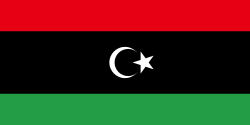| Anti-Gaddafi forces | |
|---|---|
 The former Libyan flag used during the monarchy (1951–69) had been used by some protesters as an opposition symbol. After the war's conclusion, it once again became the flag of Libya. [1] | |
| Active | February–October 2011 |
| Country | |
| Engagements | |
The anti-Gaddafi forces, also known as the Libyan opposition or Libyan rebels, were Libyan groups that opposed and militarily defeated the government of Muammar Gaddafi during the First Libyan Civil War in 2011, killing him in the process. The Anti-Gaddafi forces were represented by the National Transitional Council and their National Liberation Army, which claimed to be the "only legitimate body representing the people of Libya and the Libyan state". [2] These opposition forces included organized and armed militia groups, participants in the Libyan Civil War, Libyan diplomats who switched their allegiance from the Gaddafi-led government, and Libyan military units that switched sides to support the protesters.
